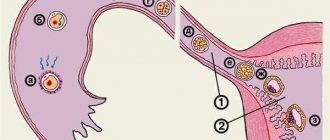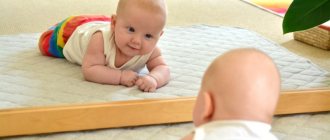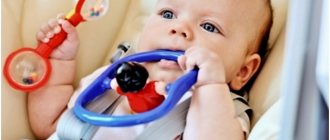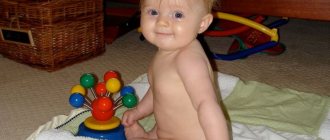More than fifty years ago there were only 16 speech therapists in Moscow. In 1951, the defectology department of the Moscow State Pedagogical Institute (now a university) graduated 30 specialists in correcting speech defects. Currently, thousands of speech therapists work in our country - graduates of Moscow pedagogical universities, as well as pedagogical institutes of regional and republican centers. And yet the problem of speech disorders remains relevant to this day. In every preschool institution, in every school there are children with speech impediments. Special kindergartens and schools have been created for children with complex speech disorders. And there are many such schools. What's the matter? How to prevent speech disorders in a child? After all, this deficiency prevents him from studying successfully, from being confident in his abilities, and makes it difficult to choose a profession.
Speech development from birth to one year
From birth, a child is surrounded by many sounds. This is the rustling of leaves outside the window, sounds of nature, noise from household appliances, ticking clocks, various musical melodies and much more. But only the sounds of speech, out of all the surrounding noise, will subsequently be the main tool for mastering the ability to speak, transmit information, encourage action and perceive speech by ear. Speech development begins long before the first words, phrases and sentences, and speech is one of the important functions in the development of a harmonious personality.
Currently, expectant parents have many opportunities to prepare for the birth of their baby. To undergo an examination while planning a pregnancy and expecting a baby, reduce the risk of pathological formation and complications during the prenatal period of the child’s development.
Prenatal development period
This is a period that characterizes the birth of a new organism and all the processes necessary for normal functioning.
Why is it important for speech development?
The formation of lower nervous activity occurs, which is responsible for the activity of the central nervous system. This activity is aimed at regulating functions within the body, at uniting it into a single whole.
Already at the twelfth week of fetal development, unconditioned reflexes begin to form: the first sucking and breathing movements. And at 4-5 months, movement of the limbs is observed. Therefore, it is especially important for the expectant mother to take care of her health, proper nutrition and daily routine in the first months of pregnancy, because by taking care of herself, she first of all protects her unborn baby from unwanted dangerous factors.
The development of the cerebral cortex, in which speech zones are formed, begins from the 3rd month of intrauterine development.
After birth, the first signal system of the newborn (sense organs: vision, hearing, touch, smell, tactile perception) is in its infancy, signs of the second signal system (speech, its perception) are absent. However, the baby exhibits reflex reactions, which will be laid as the basis for further socialization and communicative behavior. Already from the first days of life, a reaction to a person’s face, in particular the mother’s, is manifested. If such a reaction is absent, this may be a reason to consult a neurologist. There is also a vocalization component aimed at communication. This is the first cry - a sound reaction indicating discomfort, calling for the satisfaction of basic needs.
In the first year of a child’s life, parents have questions about the stages of development of physiological abilities. No less important is psycho-speech development. Knowledge of the features of the development of higher nervous activity in young children is one of the most important conditions for the effective organization of the process of raising and educating a child.
Let's consider the preparatory pre-speech period, which precedes the first words and phrases, and is an important foundation for the formation of speech processes.
Reflex scream
From the moment of birth, the child exhibits vocal reactions that are far from the sounds of human speech. These manifestations are important for the coordination of the respiratory, articulatory and vocal parts of the speech apparatus.
A baby's cry is a defensive response to physical discomfort from a physiological point of view. Screaming is one of the body's physical reactions as part of the self-regulation mechanism. It is impossible to isolate individual sounds and break them down into their components.
The vocalizations of a newborn are unusually variable, differing in nature. No two children scream the same way. The production of sound is directly related to the work of the respiratory diaphragm; the vocal cords are not involved in the formation of vocalizations. The glottis functions differently when the diaphragm operates: it is either spasmodically compressed or wide open. A cry creates the preconditions for the appearance of speech sounds in the future, similar to the formation of vowels or consonants. But by analyzing them, it can be revealed that vocalizations are structureless, like the sound signals of animals and have nothing to do with vowels or consonants.
The stage of reflex screaming and crying is important for the formation of the main speech departments, since it prepares the ground for the subsequent development of intonation, voice timbre, and activates the articulatory apparatus.
The duration of this stage is about two months. The researchers' data revealed interesting facts about the manifestation of vocalizations in infants raised in various conditions: family, child's home. Studies have shown that from the 8th week of life, a child’s crying has differences; the frequency and nature of vocalizations are influenced by breastfeeding, the mother’s reaction to a cry, the sleep patterns of children, and wearing in a sling. There is a decrease in the total number of cries in children who receive timely care and are placed in the necessary conditions.
Two weeks after birth, the baby begins to adapt more and more to the conditions of the surrounding world, the child reacts to the voice of the speaker. He can listen, stop screaming during a melodic lullaby, and turn his head in the direction of speech. Then there is a reaction to the speaker's intonation.
The time comes for the next stage of speech development.
Humming and hooting
This stage can be observed in different children from two to five months. Humming, like screaming and crying, is the essence of the implementation of the hereditary program for the development of voice in infants. They do not involve feedback and appear even in children who are deaf and mute from birth. The humming of children resembles the cooing of a dove and is a monotonous vocalization, phonation of the pre-syllable type. Humming manifests itself in the reproduction of sound complexes, short sound reactions, such as: agu, uh-huh, ubu, ebn, ebm... Such sound complexes appear when a child expresses positive emotions. The baby gurgles only when he is in the most comfortable state. Buzzing develops against the background of genetic prerequisites associated with reflexes of breathing, sucking and swallowing and plays the role of training the speech apparatus in the development of speech.
During this period, screaming continues to function in parallel with hooting and humming. It transforms into screams and crying. In this case, it is an expression of negative emotions. In situations where it is necessary to express dissatisfaction with negative contact with the outside world, crying and screaming are realized. This could be fear, pain, or uncomfortable temperature conditions.
The baby develops and discovers other interesting vocal possibilities.
Babbling
This period is observed between 4 and 7 months. The child produces syllable series that are similar to words, but do not carry meaning, for example, baba, dada, gaga, mama. The baby can pronounce sounds that are unusual for human speech, various “clicking”, “gurgling”, as well as sounds of a wide variety of languages of the world. The babbling stage is an evolution of the imitation reflex. Here echolalia takes place - imitative sounds of a child, articulated unconsciously. At the same time, the baby can imitate himself, this phenomenon is called autoecholalia. During babbling, the baby’s central nervous system, in addition to auto-auditory signals, receives a complex of kinesthetic signals when the muscles of the articulatory apparatus move. The combination of kinesthetic and auto-auditory stimuli is the basis for the emergence of speech, and “primary speech” sound complexes appear in the central nervous system. When their own kinesthetic-auditory complexes are formed, the baby recognizes them in the speech of adults and intensively repeats them on an imitative basis. If a child has not articulated any sound complexes, they do not remain in his speech base; accordingly, the baby does not hear them in the speech of adults and does not repeat them. When babbling occurs, the phenomenon of echopraxia also appears, in which the child, thanks to vision, adopts the articulation of adults.
With subsequent speech practice, individual environmental sounds are distinguished and remain close to speech sounds. By the six-month mark, the baby has introduced the phonetic features of his native language. American scientists have established this fact in studies of the babbling of children in English-speaking and Asian countries. The experiment was presented at an American educational institution, where Chinese and American students were asked to distinguish the babble of their countrymen.
The difference from the previous stage is the work of not only the articulatory apparatus, but also the auditory analyzer. The child repeats syllabic formations, or syllables, since echolalia in the babbling stage is reproduced at the syllable level.
Taking similar syllabic constructions for words, adults would like to think that the baby associates them with close relatives: mom, dad, woman, but similar syllabic structures are found in different languages and differ in meaning.
Babbling occurs due to the interconnected work of the speech motor, visual and auditory analyzers. Therefore, the most significant role is played by hearing, which allows the child to differentiate the surrounding speech and compare it with his own on an unconscious level. Parents need to carefully monitor the development of the child’s hearing and vision organs at this moment, since the lack of their functioning can lead to irreversible or difficult to eliminate defects in speech development.
In the future, as the baby develops, he gradually adopts elements of speech, such as intonation, rhythm, and tempo.
A child’s speech activity at 8-9 months allows him to imitate unfamiliar sounds. If you ask a baby where mom or dad is, he is already able to point to them, and also reacts to his own name. The child pronounces the syllables pa-pa, ba-ba, ma-ma, imitating adults, but in a real life situation he does not yet associate them with images when interacting with others.
By nine to eleven months, the baby can have the names of several objects in his passive dictionary, reacts to his name, understands words associated with routine moments, and gradually his activities become regulated by adults.
By the age of 1, the first conscious words appear, and these do not necessarily have to be complete and correctly formed forms of words. It can be: “bi-bi”, “ko-ko”, “mu”. The baby can say: “Mom and Dad.” The main thing is that the baby has a sound representation of any object, action, situation or natural phenomenon. And in subsequent speech experience, with normal development, a vocabulary is formed, both passive (what the child understands) and active (what he reproduces himself). Let's look at the table at what age a child begins to speak and how vocabulary changes every month from one to three years.
Speech is a function of the brain
Humans do not have special speech organs. Speech is realized with the help of articulation and breathing, chewing, and swallowing apparatuses that provide voice formation processes. The central link of the entire speech apparatus is the cerebral cortex (for right-handers, predominantly the left hemisphere, for left-handers, vice versa), where the representatives of the dominant hand, speech-auditory and kinesthetic (muscular) analyzers are concentrated.
In a child, the process of speech development is divided into three periods. The first - preparatory - includes screaming, humming and babbling. By screaming, the baby gives a signal to its parents, for example, that it is hungry. And thanks to the vocal reactions of humming (sounds like “ay”, “eu”), which gradually acquire different intonation colors, he masters the intonation system of the language and copies the intonations of the people around him. Booming is a consequence of randomly occurring positions of the future articulatory apparatus - lips, tongue, soft palate, pharynx and larynx. It is the same for children all over the world. It is also observed in deaf infants who have not had sound contact with their mother.
By six to eight months of life, the baby will begin to babble, pronounce sounds like “mA”, “pa”, “ba”, “na”, “di” (“go”), “da” (“give”), etc. The sound composition of babble is the result of kinesthetic “tuning” of the articulatory apparatus by auditory, acoustic imitation of the speech of others. At the same time, the child masters the elementary syllabic structure of a word, which usually consists of one syllable. If the humming does not turn into babbling, parents should worry whether the baby’s hearing is okay.
In the second period, from about eight to nine months of life, the baby begins to globally perceive the sound of certain words, with a glance or an indicating gesture to “answer” the questions “where is daddy?”, “where is the bird?” He is glad that he is understood, imitates adults in playing with toys, in manipulating a spoon, a cup. There are no words yet, but intonations and exclamations are already varying: feelings of joy and dissatisfaction are vocalized, accompanied by the characteristic sounds “a-a-a”, “oo-oo-oo”. The babbling becomes longer, the intonation coloring becomes richer, sounds begin to repeat (“ba-ba-ba”, “ma-ma-ma”) and turn into words, which, in turn, become components of thinking. And although the pronunciation of words is still very imperfect, the child puts a certain meaning into them. Seeing that mom has arrived or is leaving, he says the word “ma-ma.” These are so-called sentence words. By the end of the first year of life, onomatopoeic words like “av-av” (“dog”), “bi-bi” (“car”), “tick-tock” (“clock”) appear.
In the third period, which starts from the second year of life, the baby already understands speech addressed to him and carries out simple instructions according to the word. He makes a purposeful pointing gesture, accompanied by sounds with the intonation of a demand, which mean: name it. The child persistently moves his index finger from one object to another, returning several times to already “passed” objects until he is “satiated” with the knowledge that different objects have different names. The period of an active pointing gesture is a big leap in the development of the first stage of children's concrete-figurative thinking, associated with the primary identification of the sound envelope of a word. At this time, the child’s passive vocabulary is formed. The rapid development of speech understanding is several months ahead of the development of oral speech. Often the pause between the time when a child begins to point a finger at a particular object and the moment when he utters the word denoting the object lasts five to eight months. Finally, the turn comes when the baby makes an attempt to connect two words into a phrase (“Mom, give me”).
A hearing child, perceiving the mother’s correct, non-lisping speech, begins to speak at 14-18 months from birth. Speech development can occur differently in different children. Some develop rather slowly a utterance of two to four words, but such babies, by about one year and eight months, master the pronunciation of almost all the sounds of their native language. In another group of children, the melody of speech is rapidly developing; they pronounce long phrases, but operate with several syllables, and do not pronounce many sounds. In such cases, only the mother can make out what her baby said. It has been noticed that girls begin to speak earlier than boys; This is probably due to their more plastic nervous system.
By the age of one and a half years, the first period of questions “what is this?” arises. In the active dictionary of such a person there are already 30-35 words, consisting of one or two syllables and pronounced using six to eight sounds with different syllabic variations, which not every adult understands, but this is communication through speech.
By the age of two, a child’s vocabulary reaches approximately 300 words. He actively uses adverbs and verbs. In the third year of life, he masters the first grammatical forms, constructs multi-word phrases with complex and subordinate clauses, prepositions, adjectives, adverbs, and question words. After two and a half years, the child, in addition to an abundance of adjectives, appears participles, complex prepositions “through”, “along”, etc., and by the end of the third year of life - connecting conjunctions and pronouns. The basic formation of speech ends, but its improvement continues in the fourth and fifth years of life. This is a period of questions: “why?”, “why?”.
Speech development of a child 1-3 years old
| Child's age | Speech capabilities |
| 1 year | The baby knows and uses several babbling words, for example: “mom, dad, baba, am, aw...” The passive vocabulary is also expanded. The child already knows the names of objects used in everyday life, the names of some animals, and understands the names of all family members. |
| 1 year, 3 months | Active vocabulary increases to 30-40 words. Moreover, it is already possible to construct two-word sentences, for example: “lala buh”, “dad give”, “mama am”. |
| 1.5 years | 40-50 words, it’s easy for a child to repeat frequently repeated words after an adult, more phrases appear. |
| 1.5-2 years | The number of words and phrases is growing. The child is already able to express a lot in words. Children at this age can finish words and fragments of words when children’s rhymes, songs, and jokes are read by adults. |
| 2 years | Normal vocabulary reaches up to 200 words. Along with nouns, verbs, linking words, and adjectives appear. Three-word sentences appear. |
| 2 years, 3 months | The baby can actively talk and begins to use inflection and word formation. Spreads sentences, tries to add previously unused words to them |
| 2 years, 6 months | 200-300 words. The baby can speak in sentences and ask questions. Difficulties in sound pronunciation persist, hissing sounds (sh, g), whistling (s, z), sonorant sounds (r, l) are impaired. This is the absolute norm for this age. |
| 3 years | 1000-1500 words. The child’s speech is quite clear and understandable, sentences still include agrammatisms, but the baby can already reproduce rhymes, sing songs and is a full participant in family conversations. |
Of course, the examples given are highly averaged and perhaps reflect data from only a portion of children developing normally. Deviations in vocabulary for a couple of months do not carry any possible concerns. But it can be noted that a child of one and a half years should already be able to pronounce unstable simple phrases of two words. It is possible that the number of words in stock will not be the same as shown in the table. By the age of two, the baby can use onomatopoeia, but their number should also gradually increase.
Reasons for concern
The following signs may be a hint to your mother that it’s time to consult a specialist:
- if at one year old the child does not understand spoken speech (does not turn around when called; does not address you with the word “mom”);
- by 2 years old cannot show well-known objects, animals, or nature in a picture. (For example, “where is the cat”?);
- after 2 years does not interact with other children;
- at 2-3 years old does not fulfill the simplest requests (For example: take the ball and give it to me);
- after 3 years, he cannot pronounce most sounds, greatly twists all words, does not understand simple questions and cannot connect 3-4 words.
If the baby is about to turn 2-2.5 years old, and he does not plan to obey generally accepted norms, it is necessary to find out the reasons why speech development does not occur. This can be a disorder caused by various factors: social, physiological and mental.
- problems related to the hearing organs: it is possible that the baby has no hearing impairments;
- articulation defects: lack of mobility of the tongue muscles, tone, or vice versa, hypotonia, shortened hyoid ligament;
- psycho-emotional disorders: negativism shown in communication, violent attempts by parents to force them to pronounce the first words;
- overprotection: the child does not need to use speech, and if there are any articulation problems, the baby avoids speech contacts, since he has everything he needs whenever he gives a hint. And it is absolutely not necessary to use oral speech;
- lack of attention from parents: the use of various gadgets that impede vigorous brain activity, requiring primitive movements;
- unfavorable conditions of upbringing: scandals, screams, loud noises around, fear;
- organic lesions of the speech areas of the brain: as a result, alalia and dysarthria may occur. Various manifestations of this type of problem are determined by the severity of the damage and the location of the lesion;
- attention deficit hyperactivity disorder: neurological-behavioral developmental disorder;
- autism is a diagnosis that is quite difficult to make at this age, due to the similarity in behavioral reactions of children with autism and normotypical children.
Important!
The main condition for solving any problems is their timely identification. The sooner parents notice inconsistencies in speech development with the norm, the easier it is to eliminate the problem or make it much less noticeable and not interfere with the further development of the baby.
Talk and talk
Below are some tips for parents that promote speech development in children.
- Talk a lot. Of course, you can change your child’s diaper without opening your mouth, but the situation itself gives you the opportunity to explain the world to your child: “Look, this is your navel! Look how the car goes when we blow on it!” Obviously, babies will not understand the meaning of our words, but there are two important arguments that speak in favor of talking to babies. Firstly, children are happy to hear their mother’s voice, and secondly, first of all, by listening to speech, they learn to reproduce it themselves.
Reply. Boo-boo-boo, ha-ha-ha, as soon as a child begins to reproduce and make various sounds, he automatically becomes an interlocutor who also needs to be taken into account. He is very happy when adults reproduce his sounds as an answer, but he himself tries to imitate the sounds of mom and dad.- Listen. It makes sense to speak only when you feel that someone is listening to you with interest. Regardless of whether a one-year-old child is practicing pronunciation of a new word, or a three-year-old child talks for the seventh time about encountering a garbage truck. Listening means spending time with your child and looking at him as he speaks. If he started the conversation at the wrong time, then you need to explain this: “Get dressed first, and then you can slowly tell me what you want.”
- Read aloud. Books are fantastic things, even for the little ones. They can bite their corners, tear out pages, and at one point they will begin to pay attention to the pictures in these books. The younger the child, the simpler the illustrations should be: a ball, a car, a bear, and so on.
- Sing. Language is not only information, but also melody and rhythm. Beginners can easily learn these things through songs, poems and finger games.
- Never correct a child directly. "Grandma go home." It is clear what the baby wants to tell us, and he deserves respect and recognition. Instead of correcting your child, repeat his phrase, but in a correct way: “Yes, grandma went to her house.”
How to help a child?
At 2 years of age, a neurologist will help identify most abnormalities, who in turn will recommend other specialists necessary for diagnosis. This is an otolaryngologist, an audiologist, and a dentist. In case of defects of the articulation organs, for example, a shortened hyoid ligament, consultation with a surgeon is necessary. Also of no small importance are such teaching staff as a speech therapist, defectologist, and psychologist.
At such a young age, the baby can receive pedagogical assistance through his mother. Perhaps the baby is indicated for speech therapy massage. In this case, specialists will demonstrate to the mother what techniques can be used to help and not harm the child.
What to do if a child ignores speech addressed to him
When a preschooler throws a tantrum or argues with his parents, you can still somehow come to an agreement with him, but sometimes he can quite successfully pretend to be deaf, ignoring any appeals. This is very offensive for the mother, because she is trying to convey something important to her child, but some of her words may contradict the interests of the baby or hurt his pride. Due to their age and dependence on their parents, children cannot say this directly, so they pretend that nothing is happening.
Important! Often, ignoring the words of mom or dad is not so much a manifestation of stubbornness as an inability to defend one’s position taking into account various arguments. But this problem can be not only psychological, but also physiological (associated with difficulties understanding speech, loss of concentration or hearing loss), therefore it is recommended to consult a specialist in order to identify the cause in time.
Painting class in the “Golden Khokhloma” style in senior groups of preschool educational institutions
Tips for parents
The main thing that must be observed in the family where the baby is growing up is: comfortable conditions, routine, love, care, proper speech and psycho-emotional environment.
In the process of education, a sufficient amount of time should be devoted to the development of the child’s cognitive activity, including his speech abilities. Already from the first days of a baby’s life, his organs of hearing and vision are functioning, which allow analyzers to catch sound flashes, facial and articulatory movements of the speech organs. Parents must pronounce all words clearly without changing them. By pronouncing phrases at a slow pace, adults allow the baby to grasp the connection between kinesthetic images of sounds and audible standards.
Advice!
As early as six months, you can accustom your baby to books, reading fairy tales before bed, and looking at pictures. Equally important is the development of fine motor skills, which are directly related to the development of speech. Subtle differentiated movements of the fingers stimulate speech activity. There are many educational games for young children that have a positive effect on all-round development. Communication with your child will help achieve the most positive result.
Also, do not forget about walks in the fresh air. If possible, get used to the TV/tablet as late as possible, even to watching cartoons. Screen speech does not require a response from the child, so it not only does not contribute to speech development, but also significantly slows it down. Watching TV forms involuntary, forced attention in a child, but mastering speech requires voluntary, conscious attention, switching from object to object.
Parents should know that the most favorable and sensitive period of speech development is up to three years. If a child does not experience changes in speech development by the age of three, you should not rely on the words of friends: “Many people don’t speak until they are 3 years old” or “Someone also didn’t speak until they were three or four years old, and then they started talking and it’s completely normal.” developed.” It is necessary to contact specialists and look for problems with the onset of speech, since delayed speech development (SDD) entails many secondary problems, such as delayed mental development, general underdevelopment of speech, and at subsequent school age - dysgraphia and dyslexia, which are difficult to correct. work. Monitoring the development of the baby and taking timely measures is the main responsibility of loving parents in the process of raising a child.
Causes of speech delay and impairment in preschool age
If a child was born healthy, a delay in his speech development may occur due to incorrect actions of adults during the preparatory period: with insufficient verbal communication with the baby, inattention to his auditory perception, imitation of sounds and words of an adult, with untimely development of intonational expressiveness of speech and semantic connections between word and object.
Before speaking, the baby must train the muscles of the speech apparatus. This happens when he walks, babbles, breathes, swallows, sucks, chews. It has been noticed that children who were breastfed encounter speech difficulties less often than children who are fed artificially, and those who were promptly introduced to solid food speak much more clearly than their peers who were stuffed with liquid porridge and pureed vegetables almost before school.
Speech disturbances are caused by various reasons: congenital anomalies of the central nervous system, cerebral cortex, palate, tongue, defects in nasal breathing and decreased muscle tone of the soft palate (this pathology leads to nasality), mental trauma (for example, in impressionable children prone to neurosis a fear reaction can provoke stuttering), etc.
A child who was born deaf or who has lost hearing as a result of an illness in the first weeks and months of life will not learn to speak until a teacher of the deaf (a specialist who teaches speech to deaf children) teaches him to “lip read”, teaches him to pronounce individual sounds, and then words with relying on tactile, kinesthetic, and visual perception. Such activities should begin at the age of three or four.
The development of speech and thinking is closely related to the development of fine motor skills and coordination of finger movements. Children who work with construction sets, engage in origami, plasticine modeling, embroidery and other types of handicrafts, as a rule, are able to reason logically. Their memory and attention are quite developed.
Often, retraining a left-handed child to do everything with his right hand leads to delayed speech development and speech disorders. Modern mothers know that babies should not be swaddled. Any restriction of the baby’s movements inhibits not only the formation of motor skills, but also the timely development of speech functions. In a right-handed person, the actions of all moving parts of the body and especially the fingers, speech, articulation apparatus (larynx, pharynx, tongue, lips, soft palate) are genetically inherent in the left hemisphere of the brain, in a left-handed person - in the right hemisphere. If a left-handed person is not allowed to actively work with his left hand, then he will experience a spatial disruption in the formation of movements: the movements of the right, non-dominant hand will be stimulated, but the main, leading hand will remain without stimulation. By retraining the baby to hold a spoon or pencil in his right hand, parents thereby shift the innate functions of his leading right hemisphere to the left, in which he does not have a “projective” base for fine movements of the fingers and articulatory apparatus. As a result, speech developing on the basis of auditory perception “does not know” in which hemisphere it will “settle.” That is why often left-handers, who from infancy were diligently forced to do everything with their right hand, later begin to speak, pronounce many sounds incorrectly, are awkward in movements, do not know how to dance, and are deprived of an ear for music. But it is no less important that the emotional-volitional sphere of the child is disrupted. It is known that every action causes a reaction. The child becomes either stubborn or broken: weak-willed, suspicious, unsure of himself. He begins to pay attention to his speech difficulties and worries deeply about trifles. For this reason, he may develop a stutter. And it is difficult to overcome. A left-handed child needs to be given freedom of action, and he himself will learn to do a lot with both hands.











